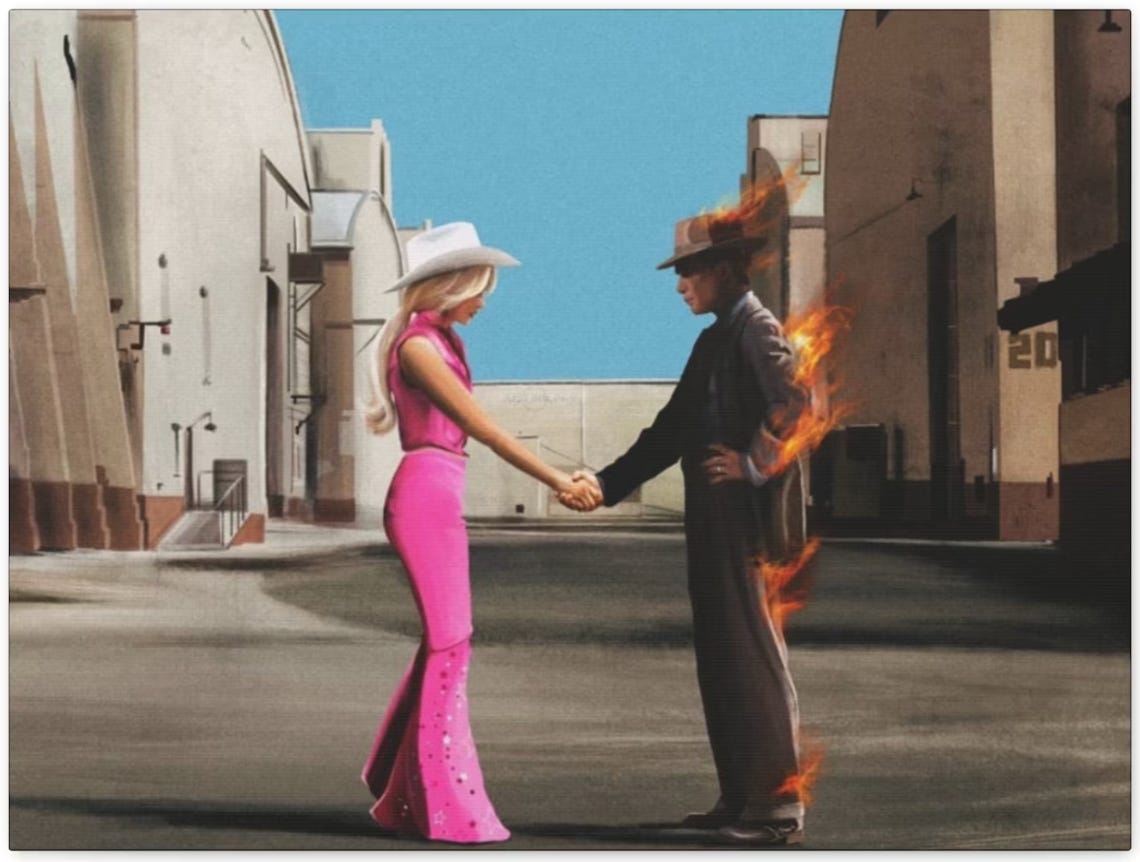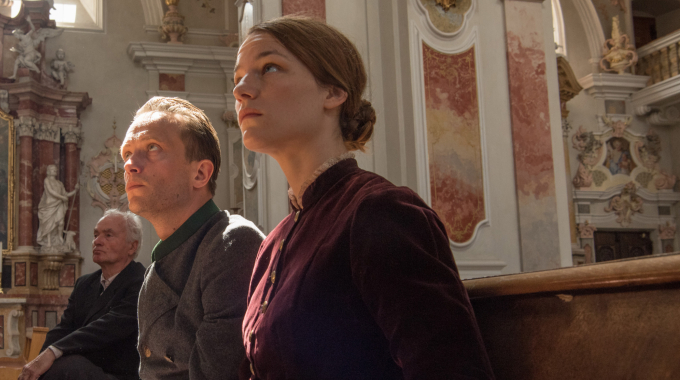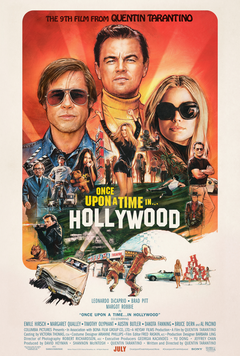As is my wont from time to time, I [briefly] review movies. Not movies that are new, which the watching public may be eagerly awaiting information about, but usually movies that were new recently—and which I’ve finally gotten around to watching (most often on DVD, thanks to the local library).
For this go-’round, though, we’re hopping in the Wayback Machine to revisit a few movies that are not new at all, and others that, though new, focus on the past for their subject. The only thread holding these together is that I’ve watched them within the past few months. Those marked with an asterisk were re-watches. So, without further ado:

Courtesy Columbia Pictures
Ghandi
Often, movies that are universally acclaimed in a given awards season (or dare we say, deliberately crafted as “Oscar-bait”), do not age well. The 55th Academy awards (honoring films made in 1982) were all aglow with Richard Attenborough’s 3-hour, giant-budget, biopic of Mohandas K. Ghandi. It swept the major categories (Best Picture, Best Director, Best Actor, Best Original Screenplay, Best Cinematography), winning 8 awards in all. I decided to dig this one up and watch it based on reading a few books about India (specifically the independence movement) this year.
It’s a long movie, to be sure, and hagiographic, and a trifle preachy, but it does still hit all the right notes. Ben Kingsley as Ghandi deserved every bit of his Oscar (even beating out Dustin Hoffman’s Tootsie). The pacing is remarkably quick and lightfooted for such a ponderous subject, and feels attuned to the humor and wit with which the Mahatma went about his calling. Mostly it works in that it doesn’t feel dated. Much of what Ghandi (or Kingsley’s version, at least) spoke about and fought for has surprising relevance today. As long as there are powerful people who ignore the poor and downtrodden, this movie will have a shelf life.
Shorter Ghandi: Ben Kingsley 4 Prez.

Courtesy Sony Pictures Classics
Capote*
A dark and stormy movie if there was one. This 2005 biopic centers on a few-year period of author Truman Capote’s life during his fascination with and investigation of the 1959 Clutter killings in rural Kansas and subsequent publishing of his “nonfiction novel”, In Cold Blood, in 1966.
Far from a procedural drama about the writing of a book, the film maintains an intense focus on Truman’s conflicted motives about forging an increasingly close relationship with one of the murderers, while juxtaposing the quiet grief of Holcomb, Kansas with the glib self-promotion of the Manhattan literati. Art and life intertwine and dissociating them becomes nearly impossible. Philip Seymour Hoffman is pitch perfect (and was rewarded with a well-deserved acting Oscar), but none of the rest of the cast Catherine Keener (as Harper Lee), Clifton Collins, Jr., Chris Cooper, Bruce Greenwood, and others, are phoning it in either.
Shorter Capote: There’s a dark side to life that only gets darker if you ignore it. Also, Philip Seymour Hoffman, we hardly knew thee.

Courtesy Entertainment Studios Motion Pictures
Chappaquiddick
On the theme of biopics focused on a slice of a life as representative of the whole, it is hard to think of anyone more defined by the events of a few moments as Ted Kennedy—the only remaining son of a legendary family who had watched his older brothers die, young and violently, one by one, and followed in their footsteps in public life as much from compulsion as calling. He was expected to run for president, to complete the family legacy, when a car accident and a fear-driven response to shade the truth ultimately ended a dynasty.
In spite of a bit of slow pacing in spots, this film works well with a very capable ensemble cast, and focus on characters decisions as much as their actions. Remarkably, Kennedy here is revealed simultaneously as a cowardly lowlife and an oddly sympathetic character (in the face of his father’s roiling disappointment). For this achievement alone, this is worth a watch.
Shorter Chappaquiddick: Moments matter, and truth is often subject to power.

Courtesy of Fox Searchlight Pictures
The Tree of Life
There are directors, there are auteurs, and then there is Terence Malick. His ambition is undeniable, but, for most audiences, a bridge too far for enjoyable cinema. His movies are so layered, so detailed, so allusive, that their meaning is elusive without lots of re-watching. Every frame is like a painting, every music choice (with a heavy emphasis on classics) carries a part of the story.
Malick’s 2011 film The Tree of Life is generally considered his magnum opus, and also one of his more financially successful ventures (#2 behind The Thin Red Line in terms of box office). Like a great novel by a Tolstoy or a Hugo, this film contains multitudes, taking a story that ostensibly takes place within a single family in a single neighborhood and expanding it to the universe itself. The family drama alone is luminous, unpacking so much mystery and beauty.
Shorter The Tree of Life: There is glory in the everyday, and a person doesn’t have to be spectacularly (or predictably?) broken to create tremendous trauma in others.

Courtesy Miramax Films
Cry, the Beloved Country*
I’m not generally fond of adaptations of literature into film. Novels and movies are just different media and each suited to different types of storytelling that don’t often overlap. Sometimes they’re not half bad, and can get enough of a story across to spark viewers to go find the book, but even a good adaptation can take the timeless themes of a good novel and anchor them in a specific time due to the filmmaking styles that (consciously or unconsciously) mirror the zeitgeist.
This is the case with 1995’s Cry, the Beloved Country, based on Alan Paton’s 1946 novel of the same name about sorrow and injustice in a South Africa then on the verge of apartheid. The film earns a certain pathos simply from being one of the first major movies made in the country under the “new management” of Nelson Mandela. A strong cast of both Western (James Earl Jones, Richard Harris) and African (Tsholofelo Wechoemang) actors turn in powerful performances, and the story generally hues to the book’s narrative, though its contours are less nuanced and the production decisions (pacing, music, shot-shaping) do feel very 90s at this remove.
Shorter Cry, the Beloved Country: Faithful adaptation, but the book has aged better.

Courtesy Columbia Pictures
The Social Network
Hype is a dangerous thing for a filmmaker. It can build up movies that aren’t worth the attention, and suck attention away from good ones. In 2010, all they hype as awards-season approached was around David Fincher and Aaron Sorkin’s The Social Network, about the building of Facebook by then Harvard student Mark Zuckerberg. The hue and cry when this new-school drama lost best picture to a very old school film (The King’s Speech) was a sight to behold.
Well, The King’s Speech is still endearing (if saccharine), but this movie seems a mess to me. Perhaps it is because none of the main characters are likable (not necessarily a problem) or remotely relatable (trust-fund kids suing other trust fund kids for IP and breach of contract isn’t exactly broad American culture). Perhaps it is because, in the intervening years, Facebook has managed to practically destroy civil discourse and undermine trust in society (well, maybe that’s a bit harsh, but). Either way, it falls flat as a story for me.
Shorter The Social Network: Why did people rave about this movie?

Courtesy Focus Features
Won’t You Be My Neighbor
When I was a kid, television consisted of two pillars—Mr. Rogers Neighborhood and Sesame Street. One of these is still running and has spawned a multi-million dollar product licensing and merchandising empire that is, at best, a distraction from the ideals of childhood learning the show set out to deliver. The other feels today like it’s from another planet, Daniel Tiger’s Neighborhood notwithstanding.
The Fred Rogers that Morgan Neville displays in Won’t You Be My Neighbor is no quaint throwback, though, but a clear-eyed warrior for a better world—in particular, one in which children, no matter how young, are taken seriously as persons and given the courtesy of wrestling with hard realities and big ideas rather than being sentenced to second-class status and kept at bay with endless cartoons and video games. There is real educational and parenting meat here, but perhaps the biggest takeaway is that Fred Rogers really was Mr. Rogers. His on screen and off screen life weren’t so different as is too common in television, and his widow, children, and staff appear in the documentary to attest to this.
Shorter Won’t You Be My Neighbor: Mr. Rogers might have been an honest-to-goodness angel, or at least a humble saint.

Courtesy Walt Disney Pictures
Solo: A Star Wars Story
At this point, it’s remarkable that any Star Wars fans remain. We’ve been bludgeoned by George Lucas with three ridiculous and unnecessary prequels and watched as Disney has cranked out new movies with lightning speed. We used to have to wait three years to be cruelly disappointed; now it happens annually. The most die-hard devotees can be forgiven for fatigue (though 2016’s Rogue One was worthwhile).
Even at all that, I had high hopes for Solo, based on three solid theses: 1) Ron Howard had ridden in on a white horse to rescue the troubled production, 2) Alden Ehrenreich (of Hail, Caesar! fame), Donald Glover, and Woody Harrelson, and 3) the fact that Han Solo was always the only truly human character in the original trilogy. Those hopes were, I’m sad to say, dashed by a glommed-together story that spends ridiculous amounts of time on forgettable side characters and “Mos Eisley Cantina” vibes (world-building based on gross-out CGI and costuming, vaguely sexualized aliens, and loud music) producers of recent Star Wars installments seem to think constitute the only fan draws. I’d watch another heist flick with Ehrenreich, Glover, and Harrelson any day, but they are drowned out by the clutter, never given a chance to shine.
Shorter Solo: Dear Disney, please stop destroying Star Wars by majoring on minors.

Courtesy HBO
Temple Grandin*
Films about disability typically come loaded with moral high-horses and themes of empowerment designed to deify the victims of disability and leave viewers feeling abashed for their unnamed prejudices. To be fair, the way that persons with disabilities are often treated in our communities justifies no small measure of this treatment in popular culture as a counterweight. Where both the daily reality and the film world fail is in treating the disabled as fully-formed human beings worthy of our attention because of their inherent dignity.
Mick Jackson manages to craft an intensely human portrait of neurological disability through the life of livestock scientist and autism advocate Temple Grandin. Relying on faithful storytelling, and a stellar cast (Claire Danes, Julia Ormond, Catherine O’Hara, and David Strathairn), and some fun cinematic flourishes of his own design, Jackson paints a picture for the neuro-typical among us that makes autism, SPD, and the like seem less like curses and more like superpowers, if properly understood and channelled. Every time I re-watch this one, I find I learn something new about my own attitudes, habits, parenting, etc.
Shorter Temple Grandin: HBO (and television more generally) is doing the heavy lifting in the entertainment industry these days, pulling off what major studios won’t touch.
***UPDATE***

Courtesy Walt Disney Pictures
Mary Poppins Returns
We took the kids to see this one on Christmas, with hopeful nostalgia welling up in equal measure to contemporary “children’s” film dread. I’ll let you guess which won by what follows.
Measuring up to one of my all-time favorite movies (and, I think, the greatest film ever produced by Walt Disney studios) was not going to be easy, but director Rob Marshall and co. didn’t really seem to give it much of a try—the cast is decent (The biggest shoes to fill here are, obviously, Julie Andrews’, but Emily Blunt’s Poppins is the film’s strongest link), the production values are OK, even the bones of the story aren’t awful (to be fair, some of the elements shoehorned into this story that work least well came directly from P. L. Travers’ books). What’s missing here is the soul. This sequel almost deliberately works to undo all the most important elements of the 1964 film. Moral lessons are swapped for look-inside-yourself drivel; honest reckoning with the difficulties of life takes a back seat to a contrived problem and pointless villain; taking children seriously as persons devolves to another recycled children-as-savior message.
Perhaps the biggest disappointment for me was seeing Lin-Manuel Miranda given so little space to be, well, Lin-Manuel Miranda. I’d have rather seen the whole project handed over to him—a hip-hop Poppins’ set in East Ham with Idris Elba as Bert would’ve at least had some natural heart….
Shorter Mary Poppins Returns: Impractical and imperfect in so many ways. What postmodern dreck.

























